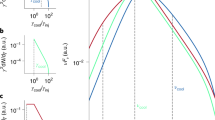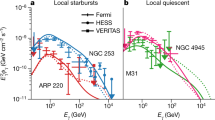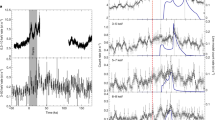Abstract
SELF-ABSORBED synchrotron radiation produced by electrons with a power-law distribution of energies has a unique spectral shape: intensity Iν ∝ ν5/2(where ν is frequency), irrespective of the power law index of the electrons1. This well-known result has been applied recently to the 'far-infrared turnovers' observed in the spectra of many radio-quiet active galactic nuclei (AGNs) 2–4. It has been asserted that the measurement of a spectral index greater than 5/2 at frequencies below the turnover is incompatible with the physics of self-absorbed synchrotron sources. Several observations suggesting larger indices (steeper slopes) 5–7 between the far-infrared and millimetre bands have been interpreted as evidence that emission by warm dust, not synchrotron radiation, dominates the far-infrared spectrum. Rees8 has, however, pointed out that this assertion is not necessarily true. Here we show that plausible electron energy distributions can lead to self-absorbed synchrotron spectra which are steeper than ν5/2 over 1–1.5 orders of magnitude in frequency. This indicates that none of the existing observations are in fact incompatible with self-absorbed synchrotron radiation as the source.
This is a preview of subscription content, access via your institution
Access options
Subscribe to this journal
Receive 51 print issues and online access
$199.00 per year
only $3.90 per issue
Buy this article
- Purchase on Springer Link
- Instant access to full article PDF
Prices may be subject to local taxes which are calculated during checkout
Similar content being viewed by others
References
Rybicki, G. B. & Lightman, A. P. Radiative Processes in Astrophysics (Wiley, New York, 1979).
Edelson, R. A. Astrophys. J. 309, L69–L72 (1986).
Edelson, R. A. & Malkan, M. A. Astrophys. J. 308, 59–77 (1986).
Edelson, R. A., Malkan, M. A. & Rieke, G. H. Astrophys. J. 321, 233–250 (1987).
Engargiola, G., Harper, D. A., Elvis, M. & Willner, S. P. Astrophys. J. 332, L19–L22 (1988).
Chini, R., Kreysa, E. & Biermann, P. L. Astr. Astrophys. (submitted).
Edelson, R. A., Gear, W. K. P., Malkan, M. A. & Robson, E. I. Nature 336, 749–751 (1988).
Rees, M. J. Mon. Not. R. astr. Soc. 136, 279–291 (1967).
Melrose, D. B. Plasma Astrophysics Vol. 1, (Gordon and Breach, New York, 1978).
De Kool, M., Begelman, M. C. & Sikora, M. Astrophys. J. 337, 66–77 (1989).
Ghisellini, G., Guilbert, P. W. & Svensson, R. Astrophys. J. 334, L5–L8 (1988).
Author information
Authors and Affiliations
Rights and permissions
About this article
Cite this article
de Kool, M., Begelman, M. Production of self-absorbed synchrotron spectra steeper than ν5/2. Nature 338, 484–485 (1989). https://doi.org/10.1038/338484a0
Received:
Accepted:
Issue Date:
DOI: https://doi.org/10.1038/338484a0
Comments
By submitting a comment you agree to abide by our Terms and Community Guidelines. If you find something abusive or that does not comply with our terms or guidelines please flag it as inappropriate.



